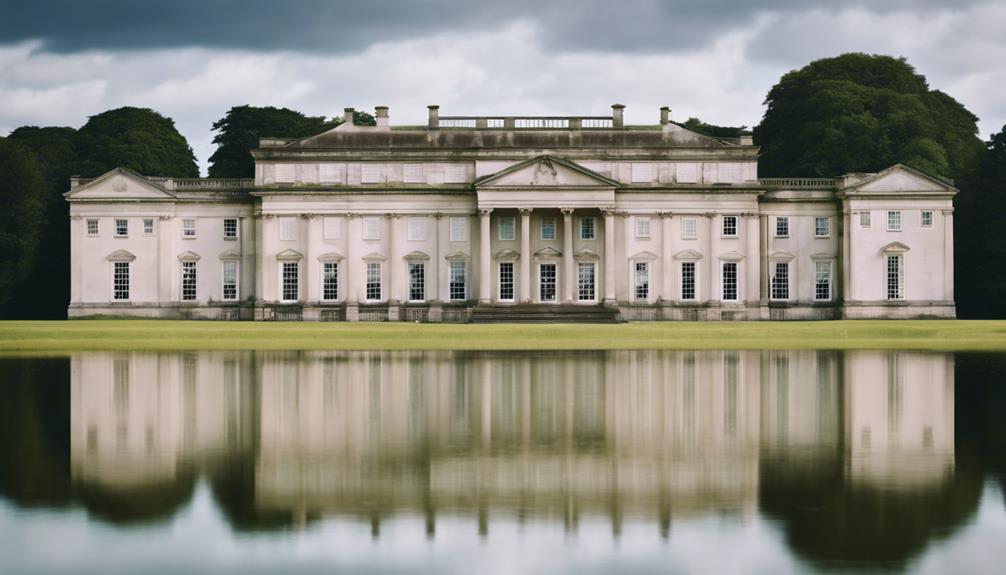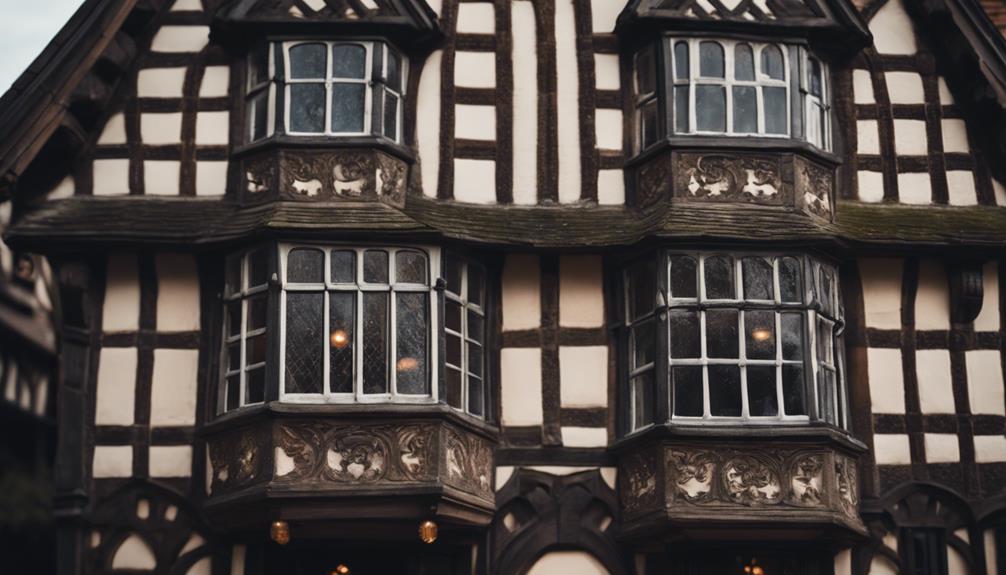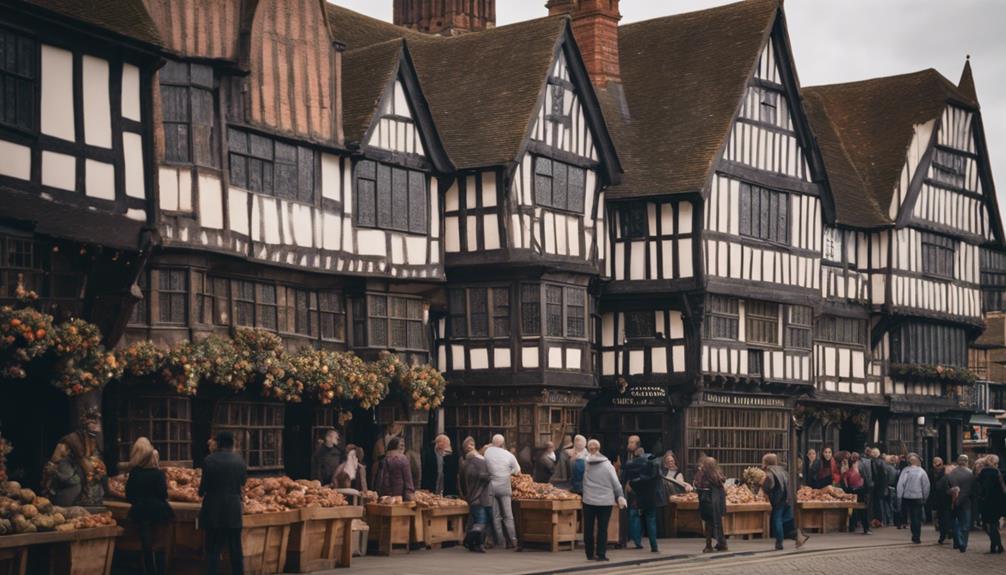Historical Landmarks in Staffordshire Towns and Cities
Begin a journey through time by exploring these historical gems in Staffordshire towns and cities. Visit Tutbury Castle, once home to Mary Queen of Scots. Explore Tamworth Castle's medieval wonders and artifacts. Unearth Roman history at Wall Roman Site, a vital post for soldiers. Marvel at Lichfield Cathedral's unique three spires and treasures. Discover industrial heritage at Chatterley Whitfield Colliery. Experience architectural grandeur at Shugborough Hall and Mow Cop Castle. The Ancient High House offers a peek into Elizabethan life. Stafford Castle's Norman roots provide a glimpse into the past. Start on a journey through time by exploring these historical gems in Staffordshire towns and cities.
Key Takeaways
- Tutbury Castle: Norman ruins housing Mary Queen of Scots.
- Tamworth Castle: Showcases medieval architecture and artifacts.
- Wall Roman Site: Roman military post with on-site museum.
- Lichfield Cathedral: Medieval cathedral with historic treasures.
- Chatterley Whitfield Colliery: Largest remaining colliery site in Britain.
Blore Heath
Over 560 years ago, Blore Heath witnessed the second battle of the Wars of the Roses, where over 3,000 men lost their lives in a fierce conflict that left local streams running red with blood. The battlefield preservation at Blore Heath guarantees that this historical site remains intact, allowing visitors like you to step back in time and connect with the past. This significant location holds a deep historical significance, showcasing a pivotal moment in English history that shaped the course of the Wars of the Roses.
Local legends surrounding Blore Heath speak of the intense battle that took place here, with stories of streams turning red with blood capturing the imagination of those who visit. These tales add an element of mystery and intrigue to this already historically rich site. As you explore the preserved battlefield, you can't help but feel a sense of belonging to the shared history of those who fought bravely on this hallowed ground.
Tutbury Castle
Tutbury Castle, a striking medieval fortress in Staffordshire, housed the infamous Mary Queen of Scots during a tumultuous period in history. The castle's ruins, originating from the 14th and 15th centuries, provide a window into its fascinating past.
As a Scheduled Ancient Monument, Tutbury Castle welcomes visitors to explore its grounds and admire original 16th and 17th-century furniture. Seized by Parliament in the English Civil War, the castle transformed into a museum in 1899, preserving its historical significance.
Overlooking the River Anker into the River Tame, Tutbury Castle stands proudly as a Grade I listed Norman castle in England. The castle's association with Mary Queen of Scots adds an extra layer of intrigue, allowing visitors to immerse themselves in the medieval imprisonment of this iconic historical figure.
Explore Tutbury Castle to experience a piece of Staffordshire's rich heritage and connect with the past in a meaningful way.
Tamworth Castle

Nestled along the River Anker in Staffordshire, Tamworth Castle stands as a Grade I listed Norman castle with roots tracing back to the 8th century. When you visit Tamworth Castle, you'll encounter:
- Medieval Architecture: The castle showcases remarkable medieval architecture, offering a glimpse into the past when it was first constructed by Mercian king Offa.
- Historical Artifacts: Inside, you'll find original 16th and 17th-century furniture and artifacts that highlight the castle's historical significance, providing a tangible link to the past.
- Civil War Capture: Witness the impact of history as you learn about Tamworth Castle's capture by Parliament during the English Civil War, a moment that shaped its legacy.
- Norman Origins: Explore the Norman origins of the castle, understanding how its foundations laid centuries ago still stand strong today, telling stories of resilience and endurance.
Tamworth Castle, with its rich history and architectural marvels, invites you to step back in time and immerse yourself in the tales of the past.
Wall Roman Site
Established in 50 AD during the Roman invasion, the Wall Roman Site in Staffordshire served as an essential military staging post for Roman soldiers passing through the area. This site played a pivotal role in the Roman military infrastructure, providing a strategic crossroads for troops moving across the region. Managed by English Heritage and the National Trust, the Wall Roman Site preserves its historical significance, offering visitors a glimpse into the Roman presence in ancient Staffordshire.
At the Wall Roman Site, you can explore an on-site museum showcasing a variety of archaeological artifacts unearthed from this historical location. These artifacts provide valuable insights into the daily lives of Roman soldiers and civilians who once occupied this area. By examining these remnants of the past, you can better understand the impact of Roman influence on Staffordshire and appreciate the military history that shaped this region. Immerse yourself in this ancient site to connect with the rich heritage of Staffordshire and the enduring legacy of the Roman military presence.
Lichfield Cathedral

The historical importance of Lichfield Cathedral in Staffordshire dates back to its establishment in 700 by Bishop Headda, making it a prominent landmark with unique architectural features.
Here are some key aspects you may find fascinating about this iconic cathedral:
- Architectural Marvels: Lichfield Cathedral stands out as the only medieval English cathedral with three spires, showcasing exquisite craftsmanship and design that have stood the test of time.
- Cultural Heritage: The cathedral's rich history is intertwined with cultural heritage, housing treasures like the Lichfield Gospels and the Lichfield Angel, which are significant pieces of art and craftsmanship.
- Fortress History: During the English Civil War, from 1643 to 1646, the cathedral served as a fortress, adding a layer of historical depth to its story.
- COVID-19 Vaccinations: In recent times, Lichfield Cathedral played an important role in the community by becoming the first place of worship in England to offer COVID-19 vaccinations, showcasing its continued relevance and adaptability to changing times.
Chatterley Whitfield Colliery
With its towering structures and rich industrial history, Chatterley Whitfield Colliery stands as a demonstration of Staffordshire's coal mining heritage. This disused coal mine, the largest remaining colliery site in Britain, played an important role in the UK's coal industry. Visitors can explore the site's historical importance, learning about industrial heritage and mining techniques that shaped the region. Situated in Staffordshire, the colliery offers insights into the area's industrial past, showcasing the impact of coal mining on the community.
Efforts have been made towards the restoration of Chatterley Whitfield Colliery, with community involvement playing a significant role in preserving this historical landmark. The accompanying Heritage Centre provides a platform for people to engage with the site's heritage, fostering a sense of belonging and connection to the region's industrial roots. During Heritage Open Days, the public has the opportunity to investigate the rich history of the colliery, gaining a deeper appreciation for its significance in Staffordshire's heritage.
Shugborough Hall

Nestled in the heart of Staffordshire, Shugborough Hall captivates visitors with its elegant Rococo architecture and meticulously landscaped grounds. Here are four reasons why a visit to Shugborough Hall is a must:
- Architectural Marvel: Designed by the renowned architect Thomas Wright, Shugborough Hall showcases the intricate beauty of Rococo architecture, transporting you back to the 18th century.
- Historical Artifacts: The estate boasts a rich collection of historical artifacts, offering a glimpse into the past and providing a deeper understanding of the hall's heritage.
- Museum Exhibits: Step inside the hall to explore the museum exhibits that shed light on the estate's history, from its construction to the lives of the people who once called it home.
- Picturesque Gardens: Wander through the meticulously landscaped gardens surrounding the hall, where every turn reveals a new vista to admire and appreciate.
Immerse yourself in the grandeur and history of Shugborough Hall, a place where the past comes alive, and stories waiting to be discovered.
Mow Cop Castle
Shugborough Hall's charm and historical allure seamlessly blend with the distinctive architectural design of Mow Cop Castle, a mesmerizing landmark in Staffordshire. Built in 1754, this grand fortified tower stands out with its fantastical summerhouse design, a confirmation of the architectural trends of the 18th century. Positioned on the boundary between Cheshire and Staffordshire, Mow Cop Castle's striking presence offers insights into local history, making it a unique historical site in the region.
Evidence of Iron Age connections further enhances the historical significance of Mow Cop Castle, adding layers of intrigue to its story. The castle's construction not only reflects the craftsmanship of its time but also serves as a window into the past, shedding light on the area's ancient roots. As you explore this landmark, you'll find yourself transported back in time, connecting with the rich history that permeates the walls of Mow Cop Castle.
The Ancient High House

Standing proudly in the heart of Stafford, the Ancient High House, built in 1595 by the Dorrington family, is a remarkable Elizabethan town house that serves as a fascinating window into the town's rich history.
Here's what makes this historic landmark so special:
- Historic Significance: The Ancient High House is the largest Elizabethan timber-framed town house in Staffordshire, showcasing the architectural style of the Elizabethan era.
- Period Furnishings: Inside, you'll find period furnishings that offer a glimpse into life during that time, providing a tangible connection to the past.
- Royal Visit: King Charles I himself visited the Ancient High House during the English Civil War, adding to its historical importance.
- Public Access: Today, the Ancient High House functions as a historic house museum open to the public, making it a valuable resource for those interested in Elizabethan architecture and historic preservation.
Visiting the Ancient High House allows you to step back in time and immerse yourself in the rich history of Stafford, fostering a sense of belonging to the town's heritage.
Stafford Castle
Stafford Castle, a Norman castle ruin in Stafford, holds significant historical importance and underwent a Gothic Revival remodel in the 19th century. Lady Isabel Stafford, who had ties to the castle, saw its stone keep demolished after the Royalist defeat.
The castle's ruins stand tall as a major landmark in Staffordshire, welcoming all who seek to explore its historical insights. Serving as a stronghold for Lady Isabel Stafford, the castle boasts a notable motte and bailey system on its expansive grounds.
Visitors to Stafford Castle can enjoy a pleasant woodland path leading to the castle, informative boards offering glimpses into its past, and stunning scenic views. The Gothic Revival redesign in the 19th century added an intriguing layer to the castle's already rich history, making it a must-visit for history enthusiasts and those seeking a connection to Stafford's historical roots.
Conclusion
To sum up, Staffordshire towns and cities are rich in historical landmarks that offer a glimpse into the region's past. From the battlefield of Blore Heath to the grandeur of Lichfield Cathedral, each site tells a story of centuries gone by.
Whether exploring Tutbury Castle or admiring the Roman ruins at Wall, visitors can immerse themselves in the history and heritage of Staffordshire. These landmarks serve as a reminder of the rich cultural tapestry that makes this region so special.

